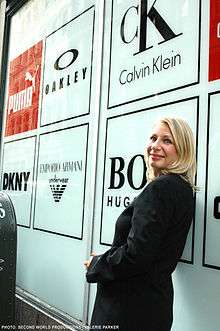Anna Klingmann
| Anna Klingmann | |
|---|---|
 | |
| Born |
1965 Germany |
| Nationality | German |
| Alma mater | Berlin University of the Arts, Architectural Association School of Architecture, Pratt Institute |
| Occupation | Architect |
| Practice | Klingmann Architects and Brand Consultants |
| Projects | Khawr Awqad, Mixed Use Community, Middle East, Esplanade, Middle East, World Coffee Natural Oasis, World Coffee Fellowship |
Anna Klingmann (born 1965) is a German architect, author and academic who specializes in branding. She is the founder and principal architect of Klingmann Architects and Brand Consultants,[1] and author of Brandscapes: Architecture in the Experience Economy.[2] Klingmann coined the term "brandism" which describes how architecture can communicate a company's brand to the public.[1] Her description of brandism can also be used not just to describe single structures; entire cities can have a unique brand or "expression of identity."[3] She also has described the concept of a "brandscape" which describes corporate value systems embodied into the physical landscape.[4] Klingmann believes that branded landscapes "effect lasting, meaningful changes that draw upon the dormant or explicit potential of particular cultures and places."[5]
Klingmann moved to New York City in 1984 and went to the Parson's School of Design.[2] She earned her architecture degrees from Pratt Institute, the Architectural Association in London and the Berlin University of the Arts.[6]
Klingmann's main influence is Louis Kahn.[2] Other influences include Zaha Hadid and Rem Koolhaas.[6] In 2007, she worked for the architecture firm, Gensler, to help on two large-scale projects.[7] In 2014, she began a collaborative project with the University and the Saudi Commission for Tourism and Antiquities (SCTA) which looks to connect artists, scientists, curators, and others with the history and culture of Asir.[8]
Klingmann is currently the architecture department chair at Dar Al-Hekma University.[9] She has previously taught at Cornell University and Columbia University.[10]
References
- 1 2 Croft, Catherine (12 October 2007). "From Bland to Brand". Building Design (1791): 20–21. Retrieved 6 September 2016 – via EBSCOhost. (subscription required (help)).
- 1 2 3 Parman, John (March 2008). "Brandscapes: Architecture in the Experience Economy". Architectural Record. 196 (3): 30. Retrieved 6 September 2016 – via EBSCOhost. (subscription required (help)).
- ↑ "The Futurist Bookshelf". Futurist. 42 (3): 58. May 2008. Retrieved 6 September 2016 – via EBSCOhost. (subscription required (help)).
- ↑ Alston, Adam (2016). Beyond Immersive Theatre: Aesthetics, Politics and Productive Participation. Palgrave Macmillan. p. 126. ISBN 9781137480439.
- ↑ Shaffer, David (9 July 2012). "Commentary: When Architecture Becomes Advertising". Daily Journal of Commerce. Retrieved 6 September 2016 – via HighBeam Research. (subscription required (help)).
- 1 2 Lukas, Scott (2013). The Immersive Worlds Handbook: Designing Theme Parks and Consumer Spaces. Focal Press. pp. 190–192. ISBN 9780240820934.
- ↑ "Gensler Retains Klingmann for Two Major Projects". Real Estate Weekly. 22 August 2007. Retrieved 6 September 2016 – via HighBeam Research. (subscription required (help)).
- ↑ "Dar Al-Hekma, SCTA Initiate 'Reinventing Asir' Project". Arab News. 22 November 2014. Retrieved 6 September 2016 – via HighBeam Research. (subscription required (help)).
- ↑ Al-Fawaz, Nadia (26 September 2014). "German Engineer Initiates Massive Architectural Revival Initiative". Arab News. Retrieved 6 September 2016 – via HighBeam Research. (subscription required (help)).
- ↑ "Brandism Exhibit to Explore NYC Starchitecture". Real Estate Weekly. 12 July 2006. Retrieved 6 September 2016 – via HighBeam Research. (subscription required (help)).